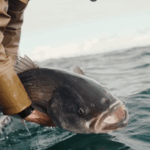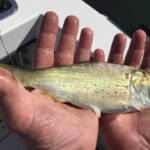
Release Mortality Revisited: New Research from Massachusetts DMF
Feature Photo Credit: Robbie Tartaglia What’s going on? For decades, striped bass management relied on a
Cover Photo: James Manning, @TheAnglersLens
Catch and Release Science on Striped Bass
New Information Could Lead the Way to Better Management
Author: Tony Friedrich
The Diodati and Richards study, Mortality of Striped Bass Hooked and Released in Saltwater, was originally released in 1996. There has not been a lot of work done on catch and release mortality since then, even though technology has grown by leaps and bounds.
Diodati and Richards performed their research because earlier studies in freshwater found that, “Hooking mortality of striped bass to average 15.6% for fish taken on artificial lures and 30.7% for fish taken on natural baits. Hysmith et al. (1993), also working in freshwater, found mortality of striped bass to be significantly related to fish length, season, and bait type. There was a positive relation between hooking mortality and length class. Overall, hooking mortality was 38% but was higher when live baits were used (58%) and was higher in the summer (47%) than winter (13%). Experiments on striped bass in brackish-water environments suggest that salinity may have an important ameliorating effect on hooking mortality.”
Striped bass are extremely important to the saltwater recreational fishing economy. Anglers catch and release millions of striped bass annually, because this is a fish of opportunity and experience rather than a ‘fill the cooler species.’ Diodati and Richards took on the challenge to better understand how saltwater striped bass respond to catch and release.
The big takeaways from the Diodati study are that the gear type and where the fish is hooked are big factors in the fish surviving release. This study was done in the summer in a salt pond. The biggest factors are detailed here.
The thing that jumps out to us is that these fish were netted, transported to a salt pond, caught by anglers, tagged, and then released yet only 3% of those fish died when hooked under the best set while almost ten times that percentage died when hooked deeply. The final analysis can be seen here.

Mass DMF initiated a new study on catch and release mortality, and the preliminary data is starting to roll in. Keep in mind that this study has not gone through the peer review process. The numbers we are going to show you are the best right now. That may change a little as the research continues.
ASGA has a ton of respect for Mass DMF. As far as state agencies go, they get extremely high marks from us across the board, and this study is no different. Their study is using the latest and greatest technology with acoustic tags. They are looking at gear type on a much more granular level. They have four different levels for the condition of the fish upon release. Time out of the water is being reviewed as well as water temperature, fight time, lure/bait, and terminal tackle like circle hooks. They are conducting DNA research that will allow the ASMFC to attribute coastal harvest to specific spawning populations and perhaps manage striped bass at more localized levels. Maybe one spawning population is doing well. Maybe another isn’t. Should the regulations be different for those areas? This is the type of work that could give us those answers. In other words, these are comprehensive studies being done by an incredibly competent state agency. We have very high hopes.
The figure below is from a Mass DMF presentation and shows what release mortality is depending on where the fish was hooked, time out of the water, and water temperature.

Here is another graph with the same information just presented in a different manner:

You can see that where the fish is hooked is a huge factor in the fish surviving catch and release. If hooked in the mouth, we have a 3% mortality rate if the fish is released in under 30 seconds and water temperature has little impact. On the other end of the spectrum, a gill hooked fish has an 87% mortality rate if kept out of the water for over two minutes. Fish hooked in the stomach can range from around 30% to 52% depending on time out of water and water temperature. It appears like water temperature has a greater impact on fish not hooked in the mouth.
Anglers have to control what we can control. Getting the fish back in the water quickly seems like the easiest hill to climb. Next time you want that picture, make it quick. If the fish is hooked in the stomach or gills, maybe a picture isn’t the best idea?
The other thing that we can control to a certain extent is where the fish is hooked. We won’t know for sure until the DMF study has been peer reviewed, until then, maybe catch and release anglers should start to look at how we are catching these fish. Are there certain methods that lead to deep hooking? If you are fishing that way, stop doing it.
The Diodati and Richards study and the new Mass DMF research are showing consensus on a major takeaway: where you hook the fish is the greatest factor in mortality. That doesn’t mean that you can keep a mouth hooked striped out of the water for five minutes. It isn’t like striped bass anglers don’t know this already. We will soon be armed with the best information we have ever had. It is up to us to use it.
Ever since the striped bass population has been on the decline, catch and release mortality has been the target of much criticism, but those comments fail to understand that catch and release mortality will ALWAYS be a substantial portion of removals, especially in a predominately recreational fishery that relies on abundance and opportunity. If one thing is certain, not all catch and release fishing is created equal. Methods where fish are less likely to be deep hooked and released quickly could go a long way in helping to recover this stock. ASGA will continue to have an open dialogue with Mass DMF on this study and report any new information that can help educate striped bass anglers on the best ways to reduce catch and release mortality.
Stay tuned for our next blog on striped bass. It will be an update on how the 2022 harvest impacted the rebuilding timeline.

Final Photo: James Manning, @TheAnglersLens

Feature Photo Credit: Robbie Tartaglia What’s going on? For decades, striped bass management relied on a

Recent developments in the 2025 Atlantic Menhaden Stock Assessment Update, released by the Atlantic States

What’s going on? The “most important fish in the sea” just exposed one of the

Mario CampoFisheries Ecologist, Southeastern Louisiana UniversityScience and Policy Associate, American Saltwater Guides Association This discussion
We rely on our members and donations to keep fighting for a sustainable tomorrow in marine conservation.
GIVE THE GIFT OF FISHERIES CONSERVATION THIS HOLIDAY SEASON. SHOP ASGA GOODS THAT FUND FISHERIES RESEARCH & ADVOCACY CAMPAIGNS
JOIN ASGA IN CALLING FOR CRITICAL MANAGEMENT ACTION AFTER YEARS OF SPAWN FAILURES & POOR MANAGEMENT.
By using this website, you agree to our use of cookies. We use cookies to provide you with a great experience and to help our website run effectively. To learn more, please review our privacy policy.
6 Responses
Using barbless or barb crimped hooks will undoubtedly lower mortality rates by reducing the physical damage at the hooking site and by reducing the overall handling time. This is something we can control. Thank you ASGA and Massachusetts fisheries scientists.
Banning treble hooks would also improve mortality rates
Yet we have Maryland taking huge mortality reduction credit for “no target” closures in April when the vast majority of catch and release anglers are using single hook artifical lures, which are not prone to deep hooking, and the water temps are cold. Then again, the state of Maryland has always been about how many fish can be put in the box vs encouraging angler trips, which is where the real socio-economic benefit of sport fishing comes from.
Don’t take the fish out of the water. Use cradle nets when able. Cease holding the fish up for photographs.
Not that you can do anything about it but the males handle the stress of being caught much better than the females